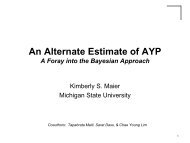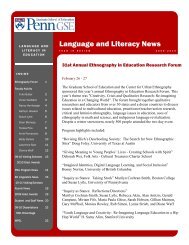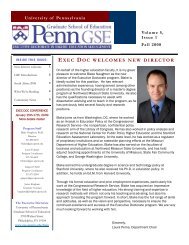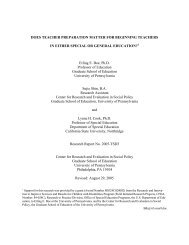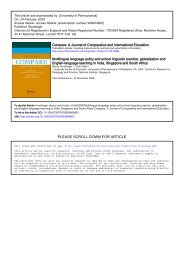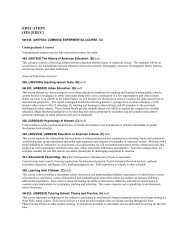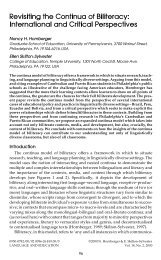Teacher turnover in special and general education: attrition
Teacher turnover in special and general education: attrition
Teacher turnover in special and general education: attrition
You also want an ePaper? Increase the reach of your titles
YUMPU automatically turns print PDFs into web optimized ePapers that Google loves.
<strong>Teacher</strong> Turnover<br />
dur<strong>in</strong>g the first 3 years of experience (with lower <strong>and</strong> stable rates dur<strong>in</strong>g the follow<strong>in</strong>g 6 years).<br />
The ma<strong>in</strong> differences were that over twice the annual percentage of SETs (than GETs) with 13-<br />
24 years of experience left teach<strong>in</strong>g, whereas more GETs (than SETs) left after 24 years of<br />
experience.<br />
Because the percentage of leavers with 1 - 5 years of teach<strong>in</strong>g experience has been of such<br />
<strong>in</strong>terest <strong>in</strong> the teacher <strong>turnover</strong> <strong>and</strong> retention literature, we also computed this quantity with f<strong>in</strong>al<br />
TFS data for the 2000-01 TFS. For full-time public school teachers <strong>in</strong> 1999-00 with 1-5 years of<br />
total teach<strong>in</strong>g experience (public <strong>and</strong>/or private, full-time <strong>and</strong>/or part-time), the five-year <strong>attrition</strong><br />
percentage was 39.6%; for part-time public school teachers <strong>in</strong> 1999-00, this percentage was<br />
67.4%; for all public school teachers (full- <strong>and</strong> part-time comb<strong>in</strong>ed), this percentage was 42.2%.<br />
<strong>Teacher</strong> Attrition Compared with Other Occupations<br />
To exam<strong>in</strong>e the possibility that teachers leave at a higher rate than <strong>in</strong> other vocations, we<br />
obta<strong>in</strong>ed a type of <strong>turnover</strong> percentage for other vocations from the only available national data<br />
source for calendar years 1991, 1994, <strong>and</strong> 2000 (BNA, 1992, 1995, 2001). Among the various<br />
bus<strong>in</strong>ess <strong>and</strong> non-bus<strong>in</strong>ess occupations for which BNA reported data, we identified the nonbus<strong>in</strong>ess<br />
category (<strong>and</strong> its subset, health care) as most comparable to the national teach<strong>in</strong>g force.<br />
BNA reported <strong>turnover</strong> at the corporate level, viz. the percentage of employees of particular<br />
corporations who leave their corporate employers annually (exclud<strong>in</strong>g departures due to<br />
reductions <strong>in</strong> force). For public school teachers, this is equivalent to <strong>attrition</strong> plus the migration<br />
of teachers from a local <strong>education</strong> agency (LEA) (i.e., the employ<strong>in</strong>g entity) to schools <strong>in</strong> a<br />
different LEA or to private schools. We termed this specific type of <strong>turnover</strong> “corporate<br />
<strong>attrition</strong>.” For public school teachers, corporate <strong>attrition</strong> therefore excludes the migration of<br />
teachers among schools with<strong>in</strong> an LEA.<br />
As seen <strong>in</strong> Figure 3, the annual corporate <strong>attrition</strong> percentage of SETs <strong>and</strong> GETs dur<strong>in</strong>g the<br />
1990s (aggregated) was comparable (about 10%), but clearly less than that from all non-bus<strong>in</strong>ess<br />
occupations (about 13%). The average corporate <strong>attrition</strong> for all employers surveyed by BNA<br />
dur<strong>in</strong>g this time was 12%. In mak<strong>in</strong>g this comparison, it is important to recognize that BNA<br />
corporate <strong>attrition</strong> data for non-bus<strong>in</strong>ess occupations excluded <strong>attrition</strong> due to reductions <strong>in</strong> force<br />
whereas the teacher <strong>attrition</strong> data <strong>in</strong>cludes reductions <strong>in</strong> force approximat<strong>in</strong>g 0.3% annually.<br />
Thus, there is no evidence that public school teachers left their LEA of employment at a higher<br />
16



